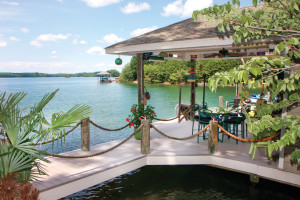 A lakeside dock is, first and foremost, a practical item, used for launching and tying up watercraft, and sometimes for the pursuit of that elusive catch. But why stop there? In recent years, docks have increasingly become places of leisure and comfort—an extension of the home, where people spend countless hours during the outdoor season. There is no shortage of ideas and gadgets to help dock owners make their waterside launch pad a destination in its own right. At Smith Mountain Lake, homeowners and builders collaborate to create dream docks that will delight and entertain for years to come.
A lakeside dock is, first and foremost, a practical item, used for launching and tying up watercraft, and sometimes for the pursuit of that elusive catch. But why stop there? In recent years, docks have increasingly become places of leisure and comfort—an extension of the home, where people spend countless hours during the outdoor season. There is no shortage of ideas and gadgets to help dock owners make their waterside launch pad a destination in its own right. At Smith Mountain Lake, homeowners and builders collaborate to create dream docks that will delight and entertain for years to come.
Party Central
Like many Smith Mountain Lake residents, Lynn and Clay Johnston fell in love with the area while on vacation. They’d been coming to the lake since 1983, and had rented a house for a number of years before finally deciding to make a permanent move from Chicago. In 2000, they built their house and its dock, which has undergone four different renovations over the years. The dock’s current style is one that truly reflects this couple’s relaxed and fun-loving approach to living—and their love of all things Jimmy Buffet.
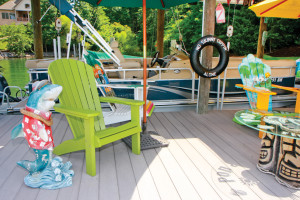 The Johnstons’ dock is designed for what Lynn calls their “sunrise-to-sunset days,” with shaded seating and amenities like a ceiling fan, stereo, and a stocked fridge in the boathouse. Clay says, “We view the dock as another room of the house,” and Lynn adds that it’s her favorite room of all. But what sets it apart from the other docks is its colorful Parrothead theme. While the Johnstons have accumulated much of the dock décor through their travels, other whimsical details have been supplied over the years by friends and family. The attractive tan-and-white shingled structure is dotted with hand-painted chairs and custom furniture, and the boathouse is hung with colorful signs and objects. Several pieces proclaim this to be “Pop and Hop’s 5 O’Clock Bar.” Lynn explains, “It’s in honor of two special people in our family that we lost. My father, Pop, in 1995, and my sister’s husband, Hop, in 2003.” As everyone knows, it’s always 5 o’clock somewhere, and the Johnstons are consummate hosts. Clay says, “We spend our weekends down there, so it’s a common occurrence when you’re having a quiet afternoon that a boat pulls up and, next thing you know, you’ve got a big party going on.”
The Johnstons’ dock is designed for what Lynn calls their “sunrise-to-sunset days,” with shaded seating and amenities like a ceiling fan, stereo, and a stocked fridge in the boathouse. Clay says, “We view the dock as another room of the house,” and Lynn adds that it’s her favorite room of all. But what sets it apart from the other docks is its colorful Parrothead theme. While the Johnstons have accumulated much of the dock décor through their travels, other whimsical details have been supplied over the years by friends and family. The attractive tan-and-white shingled structure is dotted with hand-painted chairs and custom furniture, and the boathouse is hung with colorful signs and objects. Several pieces proclaim this to be “Pop and Hop’s 5 O’Clock Bar.” Lynn explains, “It’s in honor of two special people in our family that we lost. My father, Pop, in 1995, and my sister’s husband, Hop, in 2003.” As everyone knows, it’s always 5 o’clock somewhere, and the Johnstons are consummate hosts. Clay says, “We spend our weekends down there, so it’s a common occurrence when you’re having a quiet afternoon that a boat pulls up and, next thing you know, you’ve got a big party going on.”
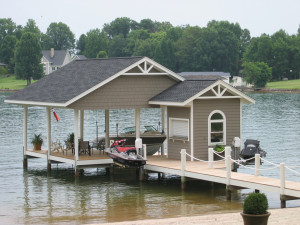 In fact, the Johnstons not only welcome these visits, they plan them. For several years now, they have hosted a “raft-up” at their dock, where people arrive by boat and tie up to a neighbor’s boat for a floating party. And not just any party: this one has live entertainment direct from Key West. For a couple of years they had popular Key West singer/songwriter Scott Kirby, and last year it was the Calypso Nuts, a steel drum duo. Clay plays steel drums and will sometimes join the entertainment, to the delight of his guests.
In fact, the Johnstons not only welcome these visits, they plan them. For several years now, they have hosted a “raft-up” at their dock, where people arrive by boat and tie up to a neighbor’s boat for a floating party. And not just any party: this one has live entertainment direct from Key West. For a couple of years they had popular Key West singer/songwriter Scott Kirby, and last year it was the Calypso Nuts, a steel drum duo. Clay plays steel drums and will sometimes join the entertainment, to the delight of his guests.
When the idea for a tropical “raft-up” first struck, the Johnstons invited some friends to drop anchor and bring their coolers, promising live entertainment. That first year, they figured the party would consist of the four or five neighboring docks in their cove, plus a few friends. As it turned out, they had 48 boats and in excess of 300 people. A friend in attendance joked that he was impressed they could throw a party for 300 people without dirtying up their house.
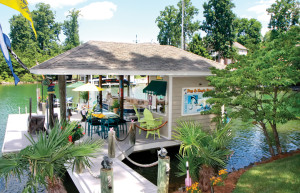 In addition to the annual bash, throughout summer at least a few other parties either are planned or just break out. On a couple of occasions, the Johnstons have tuned into Margaritaville TV, setting up a big screen on the dock and hooking up their iPad and stereo speakers to live stream a Jimmy Buffet concert. Or they’ll use satellite TV to watch a sporting event out on the dock with friends. They even hosted their nephew’s dockside wedding, with Clay officiating and the place was decked out with nice linens and silverware.
In addition to the annual bash, throughout summer at least a few other parties either are planned or just break out. On a couple of occasions, the Johnstons have tuned into Margaritaville TV, setting up a big screen on the dock and hooking up their iPad and stereo speakers to live stream a Jimmy Buffet concert. Or they’ll use satellite TV to watch a sporting event out on the dock with friends. They even hosted their nephew’s dockside wedding, with Clay officiating and the place was decked out with nice linens and silverware.
Sometimes, being the party destination means plans are subject to change. According to Lynn, her uncle and his wife visit every July to celebrate their wedding anniversary. A couple of years ago, they made a dinner reservation at The Landing and were sitting on the dock, enjoying cocktails beforehand, when a boat pulled up. “Next thing we know we have 24 people on our dock with coolers and food. Needless to say, we never made it to dinner that night!” Lynn adds that though her aunt was sorry to miss their anniversary dinner, “That’s the kind of stuff we love about living where we live.”
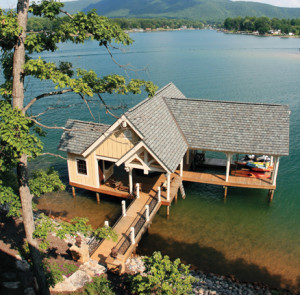 So, What Makes a Party Dock?
So, What Makes a Party Dock?
Other than having spirited, amenable hosts, what makes for a great party dock? Before building or renovating a dock, you need to make certain you have the proper permits from your county and Appalachian Electric Power. In 2003, AEP introduced a Shoreline Management Plan, which limits the size of new construction. So if you’re looking to build a dock from scratch, your builder will work with you to make sure you have the required water depth and shoreline footage to build the dock of your dreams. If, however, your dock was built prior to 2003, it might well have a larger footprint than what is possible today. Jason Turner, president of Turner’s Building, one of the largest and longest-running dock businesses on the lake, bought his lake home mostly for its oversized dock, which is almost 3,000 square feet. He says that the spaciousness of the dock, with its large boathouse and a separate storage room, as well as multiple tie-ups for boats and jet skis, meant that there was enough space for his four children and their various water toys. “Enjoyment on our dock is to be able to spend most of the day there,” says Turner. “We go down around lunchtime and are down there until dinnertime.” If you have a pre-2003 dock, upgrades are possible, as long as you stay within the existing footprint and Shoreline Management Plan’s parameters.
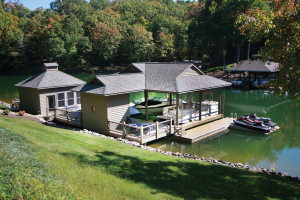 Whether doing new construction or renovation, a key consideration on a dock is layout. Turner says docks can feel congested when attention isn’t given to how people will travel around the space. For example, make sure you don’t have a narrow entrance to the main sitting area.
Whether doing new construction or renovation, a key consideration on a dock is layout. Turner says docks can feel congested when attention isn’t given to how people will travel around the space. For example, make sure you don’t have a narrow entrance to the main sitting area.
Next, think about shade. One of the first questions Turner asks a client is how much shade versus sun they’d like. Some folks want their docks entirely covered, while others like to leave some open space for sunning. Clay Johnston says that at parties, everyone tends to congregate under the shade and notes that, as he’s getting older, his feeling is, “The more shade, the better.”
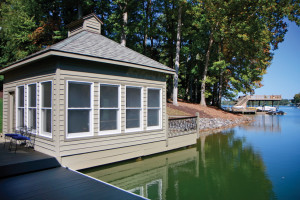 Erik Plyler, vice president of Plyler Homes and Docks, is the third generation of dock builders and land developers who have been in business over 30 years. He also suggests that clients cover a good portion of their dock with a roof to protect from sun and heat, adding, “Double-decker docks, which were popular 20 years ago, are no longer in demand because it’s just too hot up there. And the waterproofing system under that deck actually radiates heat back up.” Turner notes that in the last ten years he’s torn out of lot of double-decker docks and put on roofs instead.
Erik Plyler, vice president of Plyler Homes and Docks, is the third generation of dock builders and land developers who have been in business over 30 years. He also suggests that clients cover a good portion of their dock with a roof to protect from sun and heat, adding, “Double-decker docks, which were popular 20 years ago, are no longer in demand because it’s just too hot up there. And the waterproofing system under that deck actually radiates heat back up.” Turner notes that in the last ten years he’s torn out of lot of double-decker docks and put on roofs instead.
Most recently designed docks feature a pitched roof. A finished ceiling underneath will keep birds out of the rafters, hide lift machinery and prevent grease from dripping down, and also visually brighten the space. Add a set of pull-down attic steps, not only to service the boat lifts, but also because Plyler says with a vaulted ceiling and plywood floor, “You can use the space for extra storage, which is not counted in the 72 square-feet limit for boathouses required by the Shoreline Management Plan.” He’s also seen windows put at the end of that attic space, both for looks and ventilation. You can add a ceiling fan under your roof, though Plyler warns that some areas on the lake are windy enough to blow a fan away during a strong storm. Turner’s boathouse has a standard fan mounted to the wall of the storage area, which blows a nice breeze through the area they use to store and prep their fishing tackle.
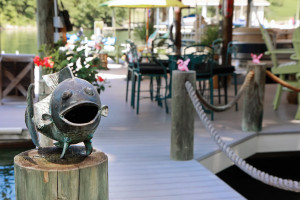 Dream docks aren’t too dreamy when they require a lot of upkeep. For this reason, many dock owners are going with maintenance-free composite decking as opposed to wood. Composite decking is eco-friendly (it’s made from scrap or reclaimed wood and recycled plastic), will last for years without having to worry about painting, warping, or rotting, and comes in a variety of colors. Plus, no splinters!
Dream docks aren’t too dreamy when they require a lot of upkeep. For this reason, many dock owners are going with maintenance-free composite decking as opposed to wood. Composite decking is eco-friendly (it’s made from scrap or reclaimed wood and recycled plastic), will last for years without having to worry about painting, warping, or rotting, and comes in a variety of colors. Plus, no splinters!
The majority of your dock is going to be stationary—supported by either treated wood pilings or steel I-beams, depending on your dock location—but it’s also nice to have a floating dock for fluctuations in water level. The floating dock will attach to your stationary structure and allow for easy in-and-out access and boat tying.
Plyler suggests completing the dock structure with a set of access stairs, which are useful for both young and old. “Build them next to the shore where the water is shallow, with a handrail and four or five steps down to the lake.”
Though new boathouses at Smith Mountain Lake have size limitations, you can still outfit them handsomely. Plyler says, “Many storage buildings can incorporate a bar with a roll-up door in the window.” Inside, keep a refrigerator stocked with cold drinks, snacks, and barware, as well as your sound system. Turner says, “A lot of docks now have granite bar countertops. We’re starting to see the same high-end materials you’d use in your home on your dock.” It’s not uncommon to see docks with flat screen TVs, and Plyler says that since an all-weather TV can cost thousands of dollars, many owners opt to place a less expensive regular TV on their dock for the season, and replace as needed.
One of Turner’s favorite features on his dock is the modified irrigation system he installed last year, which uses a pressure tank fixed to a hose bib on the outside of his boathouse. When he turns on the valve, the system pulls water from the lake and gives him water pressure to hose down the dock and his boat. Plyler says he has seen lake water used for a misting system—a neat option for those who aren’t up for a dunk on steamy summer days!
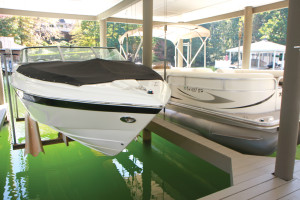 Remote-controlled gadgets are high on any list of modern dream dock attributes. Both Plyler and Turner say they install a lot of remote-control lifts for boats and jet skis, which allow you to glide in, push the button, and ride your boat up to the dock. Turner notes that it’s especially handy given the fluctuations in water level on the lake. He also enjoys having remote controls for his dock’s ceiling lights, saying that on evening cruises, “You can leave the lights off so no bugs come in, then turn them on when you get to the cove.” A final dream feature for Plyler is an automatic boat cover, a high-end component where a custom-made metal frame and cover is attached to a motor, and can mount to your boatlift. With this gadget, “You just pull your boat in, hit a button, and it’s covered,” he says.
Remote-controlled gadgets are high on any list of modern dream dock attributes. Both Plyler and Turner say they install a lot of remote-control lifts for boats and jet skis, which allow you to glide in, push the button, and ride your boat up to the dock. Turner notes that it’s especially handy given the fluctuations in water level on the lake. He also enjoys having remote controls for his dock’s ceiling lights, saying that on evening cruises, “You can leave the lights off so no bugs come in, then turn them on when you get to the cove.” A final dream feature for Plyler is an automatic boat cover, a high-end component where a custom-made metal frame and cover is attached to a motor, and can mount to your boatlift. With this gadget, “You just pull your boat in, hit a button, and it’s covered,” he says.
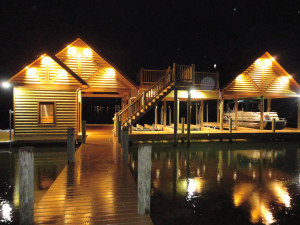 The finishing touch for creating your dream dock is one that is close to Clay Johnston’s heart. As the owner of Outdoor Lighting Expressions, Clay knows the value of creating ambiance and luster with good lighting. He uses low-voltage lighting on their dock, both for safety and to create an attractive nighttime effect on the water. With twinkle lights outlining the roofline of the dock, tiki torches here and there, and various palm and banana trees lit up on the grounds, the effect is magical and resort-like.
The finishing touch for creating your dream dock is one that is close to Clay Johnston’s heart. As the owner of Outdoor Lighting Expressions, Clay knows the value of creating ambiance and luster with good lighting. He uses low-voltage lighting on their dock, both for safety and to create an attractive nighttime effect on the water. With twinkle lights outlining the roofline of the dock, tiki torches here and there, and various palm and banana trees lit up on the grounds, the effect is magical and resort-like.
Clay and Lynn Johnston love hosting parties, and joke that their next goal is to create a music festival called “Lakestock.” But after the party’s over, their favorite time is Sunday night in their quiet cove, sipping a glass of wine on their dock at the end of another splendid sunrise-to-sunset day.
